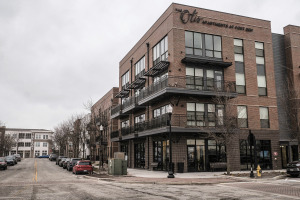Subscriber Benefit
As a subscriber you can listen to articles at work, in the car, or while you work out. Subscribe Now
If you’re living downtown or by Fort Harrison State Park in Lawrence, there’s a good chance you’re renting.
That’s according to a recent study from California-based market researcher RentCafe, which found the number of people renting in the 46204 ZIP code—which covers the core of downtown—doubled to 5,500 from 2011 to 2020.
That’s the biggest growth in renters among the city’s ZIP codes. Renters there now account for 80.5% of households, and that figure is only expected to increase with the planned development of several more apartment properties.
The next-fastest-growing area for renters is Lawrence, where 62% of people living in the 46216 ZIP code (mostly covering Fort Harrison State Park and just to its south) are renters. That’s up from 45% in 2011.
City officials say the percentage is now even higher than in 2020, because the Otis apartment building opened last year and more employers are moving their offices into Lawrence.
In downtown Indianapolis, which includes far more acreage than just the 46204 ZIP code, more than $9 billion is planned or underway, according to an IBJ analysis. About $600 million of that includes a housing component.
The biggest pocket of investment for apartments downtown is the Market East Cultural District, where redevelopment of the City Market block will add 400 residential units. A bit farther east, just outside the 46204 ZIP code, no fewer than six projects are underway.
1820 Ventures LLC is responsible for the bulk of those, with redevelopment of the former Jail II and Arrestee Processing Center buildings just west of the interstates 65/70 leg and of the former Angie’s List campus on the east side of it. In total, the firm plans to spend nearly $400 million over the next decade on those properties.
The investments are part of a long-term plan by 1820 Ventures to grow the near-east side into a true extension of downtown.
Notable apartment projects within the 46204 ZIP code include Industry Indianapolis, a 213-unit property on Pennsylvania Street, and a 270-unit project at The Stutz on Capitol Avenue.

Steve LaMotte, executive vice president and multifamily broker at the Indianapolis office of Dallas-based CBRE, said the East Washington Street corridor is becoming a growing attraction.
He likened the growth of the corridor—where TWG Development and others are building affordability-focused properties—to Fountain Square and Broad Ripple, which have seen booms in investment to become popular submarkets for renters.
“I look at East Washington Street as an extension of downtown, with obvious and clear connectivity to the downtown but with a different vibe,” he said. “It’s a lot like what we’ve seen with Fountain Square over the last 10 years, how it’s evolved from being a place that was … probably low on the list of neighborhoods to live in downtown Indy versus today. I think we’re seeing a similar evolution on the near-east side.”
The renters
He said traditional renters, like young professionals and empty-nesters, continue to dominate when it comes to those looking for spaces in both downtown and Lawrence. A large portion of people looking to rent continue to be individuals and families in need of affordable housing—a need developers in the near-east market and downtown are working to meet.
Of the 6,900 apartment units developed in central Indiana in 2022, about 7% were focused on affordability, which generally means units targeting renters earning less than the area’s median income. For a family of four, that figure is $91,300.
Jeremy Stephenson, managing partner of 1820, said he expects downtown projects to spur more interest among working-class families, particularly with each of his company’s investments having an affordability component.
“We’re trying not to be exclusive to a certain income level,” he said.
Projects like Bakery Living from TWG and multiple developments from Englewood Community Development Corp. place an emphasis on affordability, with an eye on offering downtown (or downtown-adjacent) living to everyone, regardless of income.

Englewood’s projects include The Passage, at 50 E. Shelby St., which is geared toward people with intellectual and developmental disabilities, and St. Lucas Lofts, about a mile-and-a-half to the east, which will have affordable units as well as at least 10 units of supportive housing, for people recovering from homelessness.
Joe Bowling, president of Englewood CDC, said the development opportunities on the near-east side present a unique opportunity for the city to continue developing a more economically diverse resident base.
“Neighborhoods shouldn’t be overwhelmingly low-income, and they shouldn’t be overwhelmingly high-income, either,” he said. “We really need all kinds of housing for all kinds of renters. I would make the case that affordable housing in [financially] appreciating census tracts is very important, but we also need to add housing supply … in some of our more compact areas of town, like the near-east side, that are seeing a resurgence in interest.”
Lawrence growing
Renters also are being drawn to the 46216 ZIP code, which encompasses the southern half of Fort Harrison State Park and is bordered to the west by Boy Scout Road, to the south by East 56th Street and to the south by CSX railroad tracks.
According to RentCafe, 1,273 households were renting homes or apartments in the area in 2020, up 69% over 2011.
Lawrence Deputy Mayor David Hofmann said it’s no surprise the area surrounding Fort Harrison is continuing to see an increase in renters. The Defense Finance and Accounting Service, a division of the U.S. Department of Defense, is based at the fort and employs 4,000 people, making it the city’s largest employer.
He said DFAS, other incoming employers and the Ivy Tech Community College campus—also situated at the fort—are drawing a lot of younger renters looking at Lawrence as a place to settle early in their careers, especially since home prices continue to be elevated.
“There are a lot of young professionals and a lot of college graduates who are new to the workforce and in need of a place to live,” he said. “And with housing prices being so high right now, they’re opting to choose apartment living rather than homeownership as they wait for the market to stabilize.”
While Fort Benjamin Harrison closed as a military installation nearly 30 years ago, in 1996, the campus has seen more than $200 million in investment over the past five years, accounting for new housing, retail and cultural amenities.
They include more than 700 apartments, a new branch of the Indianapolis Public Library, several restaurants and retailers, a YMCA branch and a Tru by Hilton hotel. More than 130 homes have been built since 2015 as part of The Residences at Lawrence Village project, as well.
Indianapolis-based Keystone Group is planning to break ground this summer on a $70 million development along East 56th Street, consisting of 248 apartments and more than 25,000 square feet of first-floor retail space.
The project will be the first since The Otis at Fort Ben was completed last year, adding more than 230 apartments, and will be on one of the few remaining tracts of land with 56th Street frontage that was up for repurposing from the Fort Harrison Reuse Authority.
Occupancy at The Otis now exceeds 95%, Hofmann said, adding that city officials are expecting similar success from Keystone’s project, which sits next to another vacant parcel that could be home to a medical office building or more apartments.
“It’ll be about 500 new residents coming to Lawrence once Keystone completes that project” in 2025, Hofmann said. “I think people want to live where cities are safe, where they are walkable and where everything you need is nearby.”
For its part, Keystone said the project could be a catalyst to the next phase of growth for Lawrence.
“We see a lot of potential and growth in Fort Ben and are excited to be part of the evolving community,” Jennifer Pavlik, Keystone’s chief of staff said in an email.
She said Keystone’s experience developing mixed-use projects with retail options will “continue to elevate the neighborhood for residents, visitors and those working nearby.”•
Please enable JavaScript to view this content.
